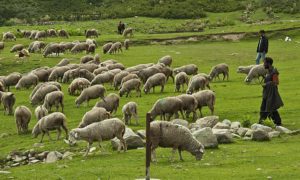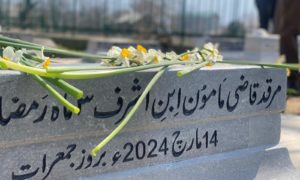In this concluding part on the waning heritage of Kashmir, experts talk about the rescue plan to safeguard the floating legacy and the iconic waters of the valley.
Lately-lifted sanctions over houseboat renovation in Kashmir’s Dal and Nigeen Lakes might’ve come as a big relief to the water-borne community, but a larger concern remains over the future course of action.
The same concern is now being voiced by the civil society members who once held positions of power and decision-making.
They bat for the community involvement in order to rescue the twin lake marvels.
Irfan Yasin, Former LAWDA Chairman

Since houseboats are the important part of our history, the argument has always been in favour of their preservation. One cannot visualize the Dal Lake without houseboats, but then it has a carrying capacity too.
This stance of human population on the lakes takes you back to the question of sewage treatment and solid wastes. There’re 4 lakh people living on the peripheries and 52 hamlets inside the lake and then there’re uncovered nearby areas like Sadribal, Hassanabad, etc.
If the government is able to solve the sanitation issue, then we can have more of houseboats floating without causing harm to the twin lakes of Dal and Nigeen.
Moreover, the sanitation solution gets easier if they’re realigned properly. For example, if they could relocate houseboats near a solid land and build proper STPs that could be used as good fertilizers for the vegetation, or they can form clusters — 10 houseboats can have a single cluster if the alignment is perfect.
Lake managers and Dal dwellers are the part of the lake’s preservation because they’ve vested interests towards saving its ecology. However, the issue is not solving because they’re not doing it together instead they throw points on each other. All the lakes saviors should sit together and find a solution.
And it’s not only sewage, everyday LAWDA [Lakes & Waterways Development Authority] collects 2 truckloads of solid waste in the morning near the Dalgate itself.
So, the pollution control measures need collective efforts from both segments — the society as well as the government.
ZG Mohammad, Columnist

It’s true that the carrying capacity of the Dal Lake has surpassed and the encroachment has widened, but water dwellers were there since ages.
Before 1947, the houseboats in the form of Dungas and Pehaz were anchored on the moving waters of the river Jhelum and were the main source of water transportation. Goods like timber and paddy used to be transported on ghats of Zaina Kadal.
But while Maharajas handed over the lakes of Dal and Nigeen to Kashmiris in their pristine form, Sheikh Abdullah allowed construction around Dal Lake which was banned during the Dogra rule. It was the beginning of decimation in the guise of tourism.
Even today, if you see right side of the Boulevard – from MA Ramzana’s showroom to the Nehru Park – all the shops and hotel owners are either the supporters of National Conference or relatives of Abdullahs. We must not forget that their shit also goes into the Dal.
When I was studying in Kashmir University in 1975, the water bodies from Ashai bagh bridge to the Nigeen were broadly open and not a single construction was there. Isn’t Dal and Nigeen consuming wastes from the other side too?
I believe government should keep 1/3rd of Dal dwellers within the lakes and scatter houseboats to different parts of Jhelum. Kashmir has so many water bodies and houseboats should not be kept limited for Srinagar only. The administration can shift them on the various waterways – from the South of Kokernag to the North of Sopore.
Zafar Meraj, Editor

We as a society have destroyed the lakes by encroaching them. And if it continues like this, the water bodies will disappear one day. Unless and until we as society won’t stand up with a collective conscience, nothing will change.
Kashmir societies clean their houses and throw garbage on road. This is our understanding of responsible citizenship and level of love for the motherland.
We’ve systematic issues in the government. 3/4th of the conservation funds go into the pockets of officers. Currently, when there is no political dispensation in the valley, the relocation and rehabilitation process can adhere without any nuisance. The administration can shift the houseboats on a backside of the Dal so that the large part of the area remains clean.
Shafi Pandit, Former Bureaucrat

When the Dal dwellers moved from Dungas to the constructed houses within the lake, they did it by filling it. The growing islands and land masses along the growing population led to the enormous degradation.
If airplanes can have waste disposals in the air, how difficult is it to implement the same on the water. They can also make a central place to compost all the waste of the Dal Lake.
The legacy of houseboats has not vanished but it had received certain setbacks because of the circumstances prevailing here.
We should understand that the numbers of huts/hamlets are more than the houseboats so shifting hamlets should be the first priority but it is also a social problem. I have faced it as the divisional commissioner. We shifted few families but they kept coming back.
Saleem Beg, INTACH Convener

Houseboats are a heritage product with its uniqueness, but then there’re consequences. One issue is the carrying capacity and second is the pollution. However, the functioning of the STPs is not the only issue, but connecting the uncovered areas is.
When the rehabilitation plan came, Dal was incorporated as part of the National Lake Conversation Plan making an essential recommendation — that the Dal dwellers are an important part of the dal ecosystem but in a limited number.
We have to accept that Dal Lake is a heavily populated urban lake and urban lakes cannot be managed by looking at the lake only as there are offshore problems.
When the Foreshore Road was created to form a setting basin, the road choked its inflows and consumed a large part of it, instead of protecting the lake.
Sadly, what should’ve happen in 5 years has not ensued in 20 years.
Shakeel Qalander, Civil Society Member

Destroying houseboats is not the solution but providing apt drainage to them is.
The focus should be on the hamlets rather than on houseboats. For example, if the government is serious to shift hamlets inside the Dal Lake, they can easily do that by raising 2 feet water level. All house holdings will submerge automatically.
Before 1947, houseboats needed permission from the government to visit the lakes or stay for 3 nights. And that’s how our lakes were preserved. But after 1947, the so-called successive governments permitted to build constructions around and inside the lakes and ignored its utilization of sewage also the methods to dispose it off.
These moves were against the life of Dal Lake and that’s why today we see our water bodies turned into a large cesspool.
The will is missing. You cannot fix problems halfheartedly. The administration is ignoring the primary issue which is the waste produced by hamlets and peripheral areas and focus on the secondary thing – that’s deweeding the lake.
Yaqoob Duno, Houseboat Owner

Houseboat industry’s legacy is dying for many reasons and the situation is one of them.
Our livelihood depends on tourism and tourists can only come when situation in the valley remains peaceful. It was never peaceful in Kashmir and there is no doubt that we suffered.
Despite all the tribulations, the Hanji community kept the tourism flame lighted.
Now the recent order has eased restrictions for the renovation of houseboats but there are Terms and Conditions.
The houseboat owners have to submit NOCs from the Electricity Dept, LAWDA, Fire Dept and Waterworks Dept.
I see this as a diversion because the court and Government of India are putting pressure on the authorities to save Dal.
Free Press Kashmir is now on Telegram. Click here to Join.
FPK Android App for 2G. Click here to Download.








